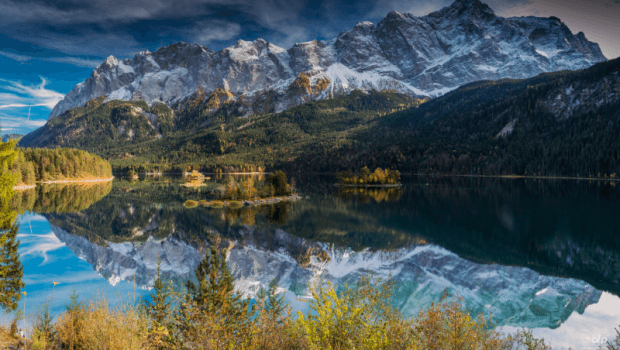
Wettersteingebirge: Adventures Galore
The name of Wettersteingebirge is widely known because it has the honor of housing Germany’s highest mountaintop, the Zugspitze. This closely packed group of mountains embodies some thrilling attributes. Let’s discover all of them!
Location:
At 47˚25’ N latitude and 11˚08’ E longitude, Wettersteingebirge, cradled within the Northern Limestone Alps or Northern Calcareous Alps (Nördliche Kalkalpen) of the Eastern Alps, is situated in Central Europe, partly in the free state of Bavaria in Germany, and partly in the federal state of Tyrol in Austria. Based in the middle of the small German town of Garmisch-Partenkirchen, the Bavarian municipality of Mittenwald, and the Austrian regions of Seefeld in Tirol and Ehrwald, this mountain range has the Ammergau Alps to its north and west, the Mieming Chain to its south, the Karwendel range to its east and the Bavarian Prealps (Bayerischen Voralpen) to its north-east as its boundaries.
Weather:
The Wetterstein Mountains experience a warm temperature of around 16 degrees Celsius in July and August, while the daily mean temperature in January falls to -2.5 degrees Celsius, making it the coldest month of the year. June, July, and August receive the maximum amount of precipitation.
History:
Millions of years ago, deposits of shell and coral layers in the Tethys Sea formed the Wettersteingebirge over time. This mountain range has been famous as the dwelling of the Zugspitze, the tallest peak in Germany. On 27th August 1820, three men – Lieutenant Josef Naus, Maier, and Johann Georg Tauschl were the first to scale the peak of Zugspitze. The Austrian Emperor Franz Joseph I gave northern Zugspitze to Bavaria in 1854. This mountain was bombed by the US Air Force during World War II, and the German-Austrian boundary was opened in 1995. In 1870, the Hochwanner, Germany’s second highest peak in the Wetterstein range, was first ascended by Hermann von Barth.
The mountain range:
Much of the Wetterstein mountain range is made up of Wetterstein limestone or Wettersteinkalk, a carbonate rock belonging to the class of sedimentary rocks from the Ladinian stage of the Middle Triassic series. Wetterstein dolomite or Wettersteindolomit has also contributed to the formation of this range. In some areas, you can identify a bright-colored combination of both limestone and dolomite.
The Wettersteingebirge is home to many of the highest mountain peaks in Germany, including the Zugspitze (2,962 m), the Schneefernerkopf (2,875 m), the Zugspitzeck (2,820 m), the Mittlere Wetterspitze (2,750 m), the Nördliche Wetterspitze(2,746 m), the Hochwanner (2,744 m), the Mittlere Höllentalspitze (2,743 m), the Innere Höllentalspitze (2,741 m) the Äußere Höllentalspitze (2,720 m), and the Hochblassen (2,706 m). Three enormous ridges, constituting the Wetterstein mountain range, come together at Zugspitze – the Riffelkamm or Waxenstein Ridge from the north, the Wetterstein Ridge, running from east to west, in the south, and the Blassenkamm or Jubiläumsgrat Ridge from the north-east.
In the Wettersteins, you can put up for the night at any one of the six mountain huts or Alpenhütte managed by the German Alpine Club, such as the Münchner Haus, at a height of 2,959 meters or 9,708 feet, which remains open for tourists from May to October, and the Höllentalanger Hut in the Höllental valley at an altitude of 1,381 meters, welcoming tourists from the end of May until the middle of October with about 70 beds. You can also find several privately run mountain huts, like the Wiener-Neustädter Hut at an altitude of 2,209 meters or 7,247 feet, where you can accommodate yourself from July till October, and the Kreuzjochhaus in the ski region of Garmisch-Partenkirchen.
How to Get There:
Garmisch-Partenkirchen, to the north, being the German town nearest to the Wetterstein Mountains, can be reached from Munich via the federal motorway Bundesautobahn 95 or A 95 on the part of the European route E533, which connects Munich with Garmisch-Partenkirchen, Mittenwald, and Seefeld in Tirol. Either from the Munich central bus station, or from Munich International Airport, you can get on the Line 040 bus to Garmisch-Partenkirchen Station (Bahnhofstraβe). You can also take a Talent 2 Regionalbahn or local passenger train serving the Munich – Garmisch-Partenkirchen railway. The track then continues from Garmisch-Partenkirchen via Mittenwald and Seefeld in Tirol to Innsbruck in Austria as the Mittenwald or Karwendel Railway. If you want to travel to the Wettersteins from Austria, take the Inntal Autobahn or Inn Valley Motorway A12 from Innsbruck or Kranebitten Airport to the city of Telfs, shift to B189, and at Nassereith, you can change to B179, and arrive across Fernpass at Ehrwald, to the west of the Wetterstein Mountains.
Once you reach Garmisch-Partenkirchen, you can take either the Bavarian Zugspitze Railway (Bayerische Zugspitzbahn) or the Eibsee cable car to the Zugspitzplatt station at a height of 2,950 meters (9,678 ft). On the Austrian side, the Tyrolean Zugspitze Cable Car takes 10 minutes to reach Zugspitzplatt from Ehrwald. Alternatively, you can find lifts at Ehrwald waiting to take you to the Wettersteins – chair lifts or Sessellifte like the Wettersteinbahn, and ski lifts or Schlepplifte such as the Gamskarlift and the Ü Skischullift.
Why visit?
Well, visiting the Wettersteingebirge gives you the opportunity to get a glimpse of Germany’s highest mountain peak, Zugspitze. Together with Germany’s highest ski resort and the highest church, Zugspitze presents you with a wonderful 360˚ view of not only the Wetterstein Mountains but also other ranges spread across four countries. You feel as though you are on top of Germany, and in reality, you are!
The Red Way of the Via Alpina (Rote Weg der Via Alpina), a long-distance trail, runs in three stages through the Wettersteins. Stage R44 to the Meiler Hut from Scharnitz through the Leutasch Gasse; Stage R45 to the Reintalanger Hut from the Meiler Hut through the Schachenhaus; and Stage R46 from the Reintalanger Hut to the Coburger Hut. Along with this trail, klettersteigs or via ferratas in the Wettersteingebirge, such as the Steig on the Riffelscharte, the Alpspitz-Ferrata, and the Steig on the Schneefernerkopf, offer adventurous routes for hiking and climbing. Most of these routes are moderately difficult, for which you require a certain amount of experience. Enthusiastic mountaineers, rock climbers, hikers, and skiers are promised sheer bliss!
Chamois, adders, Alpine salamanders, Martens and Alpine marmots are among the various species of animals found in the Wettersteins. You can also spot golden eagles and Alpine choughs flying near the summits. It’s just the place for animal lovers!
Major Attractions:
- The Zugspitze– The most visited place on the Wettersteins, apart from being the highest peak in Germany with a height of 2,962 meters (9,717 feet), it presents you with areas for sledding or tobogganing, more than a hundred ice caves below the Zugspitzplatt, and the Igloo Village or Iglu-Dorf with its different ice sculptures and even overnight accommodation. You can also go on guided tours on the Zugspitze Glacier from the Sonn-Alpin Glacier Restaurant to the Northern Schneeferner. Catholic and Protestant Mass are celebrated at the Maria Heimsuchung Chapel, the highest church in Germany.
- The Partnachklamm– The Partnach Gorge or Partnachklamm stretches for 700 meters (2,305 feet) between walls of limestone that tower up to a height of 80 meters (262 feet). It was made accessible to the public in 1912 and was previously used for drifting of wood from the Reintal. You can walk down tunnels carved out of the rock along the river flowing through this gorge, the water of which comes down from the Zugspitze. This lovely creation of nature remains open for tourists daily from 8:00 am to 7:00 pm in the period between June and October, and from 9:00 am till 6:00 pm in the winter months. However, to perceive its amazing formations of ice and snow, you need to visit this place during winter. Adults are required to pay 4 euros, while children and adolescents in the age group of 6 to 17 years gain admission for 2.50 euros. Don’t forget to take your sturdy winter boots along!
- The Chess House (Schachenhaus) – At a height of 1,866 meters, this mountain hut in the Wettersteingebirge, also known as the House on the Royal Chess, provides you with a panoramic view of the encircling Wetterstein mountain peaks and of the Reintal valley. Owned by the Bavarian Administration of State-Owned Palaces, Gardens and Lakes, this place welcomes you from late May or early June to early or mid-October with approximately 17 beds and 36 camps. Unfortunately, no room is available during winter.
- The King’s House on Schachen– This small castle, situated 1,866 meters high near the Chess House in the Wettersteingebirge on Mount Schachen, belonged to King Ludwig II of Bavaria. Its splendid couches, fine carpets, stained windows of glass, peacock feathers, and palatial chandeliers impart an Oriental flair.
- The Eibsee Lake– One of the most beautiful lakes in the Bavarian Alps, Lake Eibsee is located 13 kilometers southwest of the center of the town of Garmisch-Partenkirchen at the foot of the Zugspitze in the Wetterstein mountain range. The crystal-clear Eibsee with its emerald green water lures you for a walk in summer on the path around this lake, which is 32.5 meters (107 feet) deep.
- The Botanical Alpine Garden or Alpinum– This alpine garden, some meters below the Chess House on Schachen in Garmisch-Partenkirchen, is a branch of the Botanical Garden Munich-Nymphenburg (Botanischer Garten München-Nymphenburg) or the New Botanical Garden. Alpine Edelweiss, bellflowers, buttercups, ball flowers, carnations, and primroses are some of the alpine flora that can be found blooming in here.
- Skiing– The Wettersteingebirge has a number of ski slopes and resorts, the most famous among them being the Zugspitze. From the Wetterstein ski resort in Ehrwald, you can go to the Zugspitze to ski on the slopes for approximately 16 kilometers. If you want to ski from Mittenwald, a ski lift can take you from Isartal on the edge of the Wetterstein Mountains to the Kranzberg ski resort, where you can enjoy skiing with your family.
What else is Around?
- The Leutasch Gorge
- The Höllental or “Valley of ”
- The Riffelspitzen
- The Alpspitze
- The Mieminger Mountains or Mieminger Gebirge
All these features make the Wettersteingebirge the perfect place for all types of hair-raising adventure sports. Whether your interest lies in mountain climbing, skiing, sledding, hiking, or snowboarding, the Wetterstein mountain range is sure to bring you ecstasy. Some places in the Wetterstein, however, have never been, or are rarely, visited by people. Let out the daring spirit in you explore the unknown in the Wettersteingebirge!
